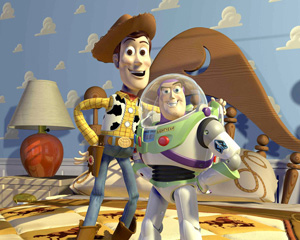 It's been awhile since Woody, Buzz, Jessie, and the gang have been on the big screen, but they've lost none of their charm in the interim.
It's been awhile since Woody, Buzz, Jessie, and the gang have been on the big screen, but they've lost none of their charm in the interim.
The third installment of the Toy Story franchise is faster, slicker, darker than its predecessors (the minimal 3-D effects seem an unnecessary nod to the latest gimmick in film technology), and 11 years of extraordinary advances at Pixar are evident in every eye-popping frame.
There are elements of the story that are alternately hilarious and disturbing -- depending, I suppose, on your point of view and your age: the large, creepy baby with the lazy eye (what girl didn't have a doll like that in the '60s or '70s?); the demented (and scented!) stuffed bear, voiced with diabolical perfection by Ned Beatty; and evil monkeys (a mushroom cloud of the iconic red [barrel of] monkeys in the opening scene and later a cymbal monkey-turned-security guard with a menacing, toothy sneer).
Panning out from these inventive particulars, we're able to see that over its 15-year history, the Toy Story franchise has guilelessly linked the simplicity of imaginative childplay to mass consumption and the planned and perceived obsolescence that's part of the marketing game. As film reviewer A.O. Scott puts it, Toy Story 3 "is as sweet, as touching, as humane a movie as you are likely to see this summer, and yet it is all about doodads stamped and molded out of plastic and polyester."
The movie keeps both of these truths in the forefront throughout: images of our culture's excesses and exorbitant waste share equal screen time with moving scenes of the sheer joy and abandon of children at play.
There are reasons to worry that kids today have less capacity for creative, bodily play, what with the prevalence of video and computer games and the sedentary lifestyles they encourage. But I sometimes think the concern is overrated. Young children everywhere seem able to invent story-worlds that engage their minds and bodies, their intellects and imaginations with whatever toys are at hand -- the makeshift kind or the latest shrink-wrapped craze. (I'm reminded of another recent movie, the excellent documentary Babies, in which an African toddler is occupied for hours with a rock and a small animal bone; she exudes intelligence throughout the film).
We may wish that our daughters preferred a simple rag doll to Beach Fun Barbie (having raised sons I happily avoided the whole Barbie dilemma, but toy guns and plastic army guys created their own set of problems). Yet play is the work that children are given to do. When they are completely absorbed by it -- practicing their language skills, learning to negotiate the world as they know it -- we can trust that what they are doing is important to their moral formation. Toy Story 3 shows just how much fun it is, too.
Debra Dean Murphy is assistant professor of religion at West Virginia Wesleyan College. She blogs at Intersections: Thoughts on Religion, Culture and Politics and at ekklesiaproject.org.
Got something to say about what you're reading? We value your feedback!